
Catharanthus is a genus of flowering plants in the family Apocynaceae. Like the genus Vinca, they are known commonly as periwinkles. There are eight known species. Seven are endemic to Madagascar, though one, C. roseus, is widely naturalized around the world. The eighth species, C. pusillus, is native to India and Sri Lanka. The name Catharanthus comes from the Greek for "pure flower".

Alstonia is a widespread genus of evergreen trees and shrubs, of the family Apocynaceae. It was named by Robert Brown in 1811, after Charles Alston (1685–1760), professor of botany at Edinburgh from 1716 to 1760.
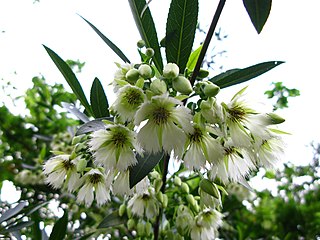
Elaeocarpus is a genus of nearly five hundred species of flowering plants in the family Elaeocarpaceae native to the Western Indian Ocean, Tropical and Subtropical Asia, and the Pacific. Plants in the genus Elaeocarpus are trees or shrubs with simple leaves, flowers with four or five petals usually, and usually blue fruit.

Ficus elastica, the rubber fig, rubber bush, rubber tree, rubber plant, or Indian rubber bush, Indian rubber tree, is a species of flowering plant in the family Moraceae, native to eastern parts of South and Southeast Asia. It has become naturalized in Sri Lanka, the West Indies, and the US state of Florida.

Mesua ferrea, the Ceylon ironwood, or cobra saffron, is a species in the family Calophyllaceae. This slow-growing tree is named after the heaviness and hardness of its timber. It is widely cultivated as an ornamental due to its graceful shape, grayish-green foliage with a beautiful pink to red flush of drooping young leaves, and large, fragrant white flowers. It is native to wet, tropical parts of Sri Lanka, India, southern Nepal, Burma, Thailand, Indochina, the Philippines, Malaysia and Sumatra, where it grows in evergreen forests, especially in river valleys. In the eastern Himalayas and Western Ghats in India it grows up to altitudes of 1,500 m (4,900 ft), while in Sri Lanka up to 1,000 m (3,300 ft). It is national tree of Sri Lanka, state tree of Mizoram and state flower of Tripura.
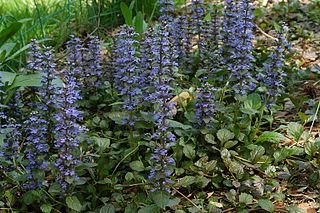
Ajuga reptans is commonly known as bugle, blue bugle, bugleherb, bugleweed, carpetweed, carpet bugleweed, and common bugle, and traditionally but less commonly as St. Lawrence plant. It is an herbaceous flowering plant, in the mint family, native to Europe. It is invasive in parts of North America. Ajuga reptans is also a component of purple moor grass and rush pastures, a Biodiversity Action Plan habitat in the United Kingdom.

Magnolia champaca, known in English as champak, is a large evergreen tree in the family Magnoliaceae. It was previously classified as Michelia champaca. It is known for its fragrant flowers, and its timber used in woodworking.

Volkameria is a genus of flowering plants in the family Lamiaceae. It is pantropical in distribution. Many of the species are found in coastal habitats.
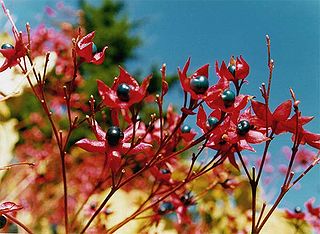
Clerodendrum is a genus of flowering plants formerly placed in the family Verbenaceae, but now considered to belong to the Lamiaceae (mint) family. Its common names include glorybower, bagflower and bleeding-heart. It is currently classified in the subfamily Ajugoideae, being one of several genera transferred from Verbenaceae to Lamiaceae in the 1990s, based on phylogenetic analysis of morphological and molecular data.

Andrographis paniculata, commonly known as creat or green chiretta, is an annual herbaceous plant in the family Acanthaceae, native to India and Sri Lanka.
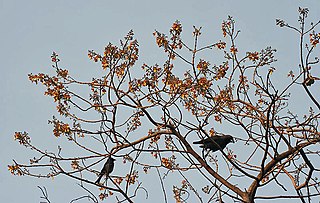
Gmelina is a genus of plants in the family Lamiaceae. It consists of about 35 species in Australia, New Guinea, New Caledonia, Southeast Asia, India and a few in Africa. Some species such as G. arborea have been planted and/or become naturalised in India, Africa and Australia. It was named by Carl Linnaeus in honour of botanist Johann Georg Gmelin.

Campylospermum serratum is a plant in the family Ochnaceae. The specific epithet serratum is from the Latin meaning "with teeth", referring to the leaf margin. It is found in Tropical Asia, from Sulawesi, Indonesia to Hainan, Zhōngguó/China and over to southwester India. Gomphia serrata was a previous common name for the species. The plant is used for it wood and its sap is used in folk medicine and in the past for teeth-blackening.

Fumaria muralis, known as common ramping-fumitory or wall fumitory, is a flowering herbaceous plant in the poppy family (Papaveraceae) native to western Europe and northwestern Africa.
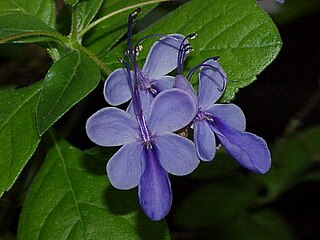
Rotheca is a genus of flowering plants in the family Lamiaceae. Estimates of the number of species in the genus vary from about 35 to as many as 60. Three of the species are native to tropical Asia, with the rest occurring in Sub-Saharan Africa. The type species for the genus is Rotheca serrata. It had originally been named Rotheca ternifolia, but this name is now considered illegitimate.
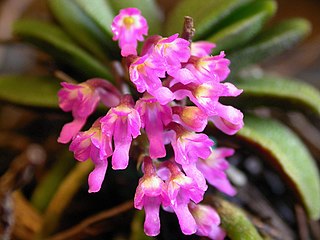
Schoenorchis, commonly known as flea orchids, or 匙唇兰属 , is a genus of flowering plants from the orchid family, Orchidaceae. Plants in this genus are small epiphytes with thin roots, thin leafy stems with leaves in two ranks and tiny fragrant, almost tube-shaped flowers with a prominently spurred labellum. There are about twenty five species found from tropical and subtropical Asia to the Western Pacific.

Tacca integrifolia, the white batflower, is a species of flowering plant in the yam family, Dioscoreaceae, native to tropical and subtropical rainforests of Asia. It was first described by the English botanist John Bellenden Ker Gawler in 1812.

Anisomeles is a genus of herbs of the family Lamiaceae and is native to China, the Indian Subcontinent, Southeast Asia, New Guinea, Australia, Madagascar, and some Pacific and Indian Ocean islands. Plants in the genus Anisomeles have small, flat, narrow elliptic to narrow e.g.-shaped leaves arranged in opposite pairs, the edges of the leaves sometimes wavy or serrated. The flowers are arranged in groups, with five sepals and five petals in two "lips", the lower lip with three lobes, the middle lobe much longer than the side lobes. There are four stamens that extend beyond the petals and a single style in a depression on top of the ovary. The fruit is a schizocarp with four nutlets containing small seeds.

Anisomeles malabarica, more commonly known as the Malabar catmint, is a species of herbaceous shrub in the family Lamiaceae. It is native to tropical and subtropical regions of India, and Sri Lanka, but can also be found in Malaysia, Bangladesh, Myanamar, Bismarck Archipelago, Mauritius, Andaman Is. and Réunion. Growing up to 2 m high, it has narrow green leaves 3–8 cm in length, and 1.5–3 cm wide. It is pollinated by sunbirds and carpenter bees, and bears purple flowers in mid spring, though it may also bear the flowers throughout the year. Originally used in Sri Lankan and Hindi folk medicine, the current main uses are medicinal, aromatics and cosmetics.

Dregea is a genus of vines in the Apocynaceae, first described as a genus with this name in 1838. It is native to Africa and southern Asia.
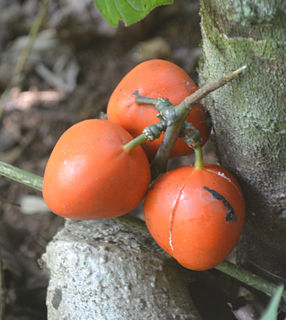
Adenia hondala, commonly known as hondala is a large, tuberous, woody climber which scrambles over other plants. It is found in the Indian subcontinent, including Sri Lanka, and in southeastern Asia. The tuber and the fruit are used as herbal remedies and the plant is used as a cure for snake bites. The caterpillars of several species of butterfly feed on this plant; these include the tawny coster, the clipper, the common cruiser and the Tamil lacewing.




















